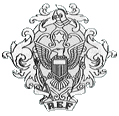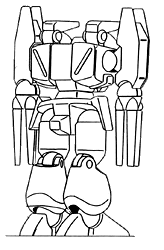

Designation:ADR-10 Mk I Catapult |

|
||||

|
|||||
| Total Height: | 9.3m |
| Total Depth: | 2.4m |
| Total Breadth: | 4.9m |
| Weight: | 17 metric tons (dry) |
| 19 metric tons (fully loaded). |

The armor on the Catapult is a new development in low-mass composite-materials Chobham plating that became the standard for all Terran mecha after its application to the VQ-6A Vandal. Aside from the respectable protection provided against projectiles, missiles, and other kinetic weapons, this armor is also resistant to plasma globes (annihilation discs), lasers, and to a lesser extent, particle guns, owing to the fact that the armor can flake off and evaporate in layers under fire from such high-energy weapons, taking much of the weapon's energy and converting it into the latent heat of sublimation in the armor. The armor stops all small arms, heavy infantry weapons fire, and light mecha-mounted weaponry, and provides good resistance to medium mecha-mounted weaponry, such as the Valkyrie's 55mm APFSDS round, and poor resistance to heavy mecha-mounted weaponry, such as the VHT's 120mm smoothbore shells.
The Catapult provides full protection from nuclear, biological, and chemical hazards, using an overpressure cockpit environment activated by radiation and hazardous chemical sensors, or manually when biological warfare conditions are anticipated. The internal consumables supplies can provide atmosphere for three days maximum.
In the drive to commission new Destroids that incorporated the newest technology, the REF planning bureau drew up in 2018 specifications for the Catapult, a replacement and complement for the Defender. Plans already existed to equip the Defender Destroids with a combined 78mm cannon/particle beam arm, and the REF planners were so impressed with the simulated effectiveness of this configuration, that they prescribed it for the Catapult as well. However, the design bureau that designed the Catapult torso (the legs were to be shared with the Excalibur and Shark) asked for and received permission to mount the successors of the 78mm cannons, the Type 1001 cannons, instead. These cannons featured an electromagnetic propellant system (Gauss cannon) and fired a smaller projectile than the 78mm's, but the muzzle velocity of this 45mm AP dart was higher. The Type 1001 shell was, because of its new warhead and kinetic penetration, as effective as the 78mm shell, but because of its lower weight the cannon could be lighter, and more ammunition could be carried. In addition, the terminal guidance could acquire more often than the semi-active laser guidance of the Defender. In total, the new cannons were better, and weighed only 70% of the 78mm cannon weight. In addition, the Mark XII Defender's two particle beam cannons were replaced with two twin particle beam cannons. Individually less powerful, when combined they produced far more on-target beam energy. The overall effectiveness was further improved by mounting two medium range missile pods (the design was taken from the Excalibur) on the shoulders. These weapons had the longest range of all weapons mounted, and turned the Catapult into an extremely effective combined SAM battery and AAA position.
The new Catapult Destroid was, as all REF ground mecha were, faster than its predecessor, as well as equally or better armored. It also looked much the same, only it was smaller and did not have a vulnerable radar antenna sticking out above it. In addition, the newer technology improved the effective firing rate somewhat: using only the autocannons, a Catapult could fire a one-second salvo at an approaching Invid mecha, then target another Invid in one second and fire another one-second salvo at that one as well. The four shells fired were usually enough to destroy smaller Invid mecha. The Catapult could keep this rate up for about five minutes, targeting 150 Invid mecha. Since it took an attacking Invid group usually a minute of in-range flight to reach an REF ground task force, this meant that one Catapult could shoot down 30 Invid mecha before they had even reached the REF forces. And, as the enemy closed, the Catapult could open up with its particle beams, increasing its high time/kill ratio even more.
The REF refitted Defender was only slightly less effective, and these two Destroids are still by far the most effective anti-aircraft mecha known. Consequently, all REF installations had a Catapult or Defender on guard at all times. On Earth, the Catapult was a very valued mecha, certainly against the Invid, who used large-number tactics by nature. The Catapult is still in production in the post-war Terran and Tirolian armies, though its relatively low mobility restricts it to base defense or ground-forces protection only.
Return to REF Index
Return to Robotech Reference Guide Home Page.
Robotech (R) is the property of Harmony Gold. This document is in no way intended to infringe upon their rights.
Content by Peter Walker and Pieter Thomassen, with Rob Morgenstern
Copyright © 1997, 1995 Robert Morgenstern, Peter Walker, Pieter Thomassen
Last Updated: Thursday, November 20, 1997 4:41 PM